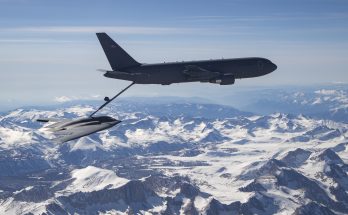
Weapons sales have long been a part of security partnerships around the world. The closer the relationship, the more advanced and complex the equipment that can be shared. Sellers may also use such sales to create dependence and enhance their influence in the buying country. These two different approaches can be seen in recent submarine deals in the Indo-Pacific, where China and the U.S. are vying for influence.
Australia Set to Join Nuclear Sub Club
In September 2021, Australia, the U.K. and the U.S. announced their intention to establish a new military and technology-sharing pact. Known as AUKUS, the accord centers on a decision to provide Australia with the technology to construct nuclear-powered submarines to replace its aging Collins-class diesel-powered boats. The move was not without controversy, hurting Australian relations with France, with which Canberra had made a $66 billion deal for 12 conventionally powered Attack class subs in 2016. The French boats, based on the Shortfin Barracuda design, were selected over offerings from Germany and Japan.
Australian defense officials said the about-face was due to a significantly changed security environment in the Indo-Pacific. Rapid military modernization in the region, and China in particular, rendered the original plan obsolete. Nuclear-powered submarines would be faster, more powerful, stealthier and better equipped to take on the coming regional challenges, the officials said.
Under the AUKUS agreement, the three countries would design and build a shared class of nuclear-powered submarines. Last week, Australian officials told lawmakers that in the early 2030s, the U.S. would transfer two Virginia class attack submarines to Australia, with Canberra buying a third off the production line. Details were still being finalized, but the intent was for those boats to have more than 20 years of service life. The subs would likely be in the Block 3 or 4 configuration, said the officials.
Meanwhile, plans call for acquiring new AUKUS nuclear-powered boats, to be designed with the U.K., in the 2050s. A planned fleet of eight subs would initially include the three Virginia class submarines, officials said.
Beyond the sub acquisition, the trilateral accord includes the right for British and U.S. nuclear-powered submarines to operate from Australian bases. As many as four U.S. subs and one British boat are expected to operate from HMAS Stirling Fleet Base West near Perth in western Australia from 2027. Upgrades to the facilities at the base have already been approved by Canberra. Funding has also been earmarked for a nuclear submarine operating base on Australia’s east coast, supporting operations in the southwestern Pacific Ocean.
If the AUKUS project is successful, Australia will become the seventh country to operate nuclear-powered submarines (or eighth, depending on the progress of Brazil’s Alvaro Alberto-class nuclear sub project). Nuclear boats offer significant advantages over conventional subs, including enhanced stealth, nearly unlimited endurance, and the ability to operate at high speed for long periods. Australian plans to increase the country’s sub fleet to eight boats from the six Collins class subs now in service would allow it to keep more of the vessels at sea at any time.
Subs in the Indo-Pacific
Submarines provide unique military capabilities regardless of their propulsion systems, but require significant investments in training and sustainment, making them something of a prestige capability. The return on investment can be significant, with subs offering the ability to stealthily interdict trade; combat surface warships; lay mines; perform intelligence, surveillance and reconnaissance missions; and support special operations. Perhaps most importantly, they can create uncertainty among adversaries, hindering or deterring potential operations.
Navies in the Indo-Pacific region have increasingly emphasized submarine capabilities in recent years, with various countries either acquiring or updating sub fleets. A variety of sellers have met this market demand: Indonesia purchased its Nagapasa class subs from South Korea; Malaysia, Perdana Menteri class boats from France; Singapore is replacing its former Swedish subs with new German-built Invincible class submarines; and Vietnam purchased its Hanoi class boats from Russia.
For its part, China has begun to use submarine sales as part of its regional diplomacy. Beijing has sold used Ming class (Type 035G) submarines to Bangladesh and Burma, as well as Yuan class submarines to Thailand and Pakistan.
Close Relationship Opens Door to Nuclear Tech
While China has become a player in the submarine market in recent years, the U.S. has been absent, beyond the potential sale of components and subsystems, due to its lack of a domestic conventional submarine builder. The last U.S. conventional submarine, USS Blueback (SS 581), entered service in 1959 and was decommissioned in 1990. China, like Russia, continues to build both conventional and nuclear boats.
The proliferation of conventional subs in the region may be among the reasons that Australia decided to move to a nuclear submarine fleet. For Washington, the deal comes with additional benefits, including access to Australian bases, potentially on a permanent rather than rotational basis. This would reduce wear on U.S. subs and crews operating in the region, while sending a clear message to Beijing.
Australia has long been a strong U.S. ally, participating in U.S. military operations from Vietnam to Iraq and the Five Eyes intelligence-sharing alliance along with Canada, New Zealand and the U.K. Winning an agreement from the U.S. to share nuclear technology, as well as the planned sale of nuclear-powered submarines, further strengthens these ties in a strategically important region. Australia is the second country to obtain such a technology transfer, following the U.K. in 1959.
While the U.S. is unlikely to export its nuclear submarine technology to other allies in the Indo-Pacific, it may be able to support partners selling conventional boats in the region. Washington has shown that it is prepared to send subsystems and components to support allied submarine-building efforts, primarily in Taiwan. Both the Trump and Biden administrations have approved the export of key equipment such as digital sonars, combat systems and periscope equipment to Taipei for its submarine project.
An Opportunity for Beijing?
China’s recent strides in submarine technology have enabled Beijing to add conventional boats to its regional arms export strategy. Such deals can give China regional beachheads and strengthen ties with countries unable to afford Western equipment or that are politically unfriendly with the West. Maintenance and support deals allow Chinese personnel to temporarily deploy to the purchasing country. Such relations could develop into opportunities for China to forward-deploy naval assets.
Where China has found gaps in the Western-dominated submarine space, it has moved to exploit them. These have often involved pariah states or those accused of human rights abuses or illiberal governments. For example, in 2015, less than a year after the Thai military seized power following months of political turmoil, the junta made a deal with China for submarines. In 2017, a $400 million contract was finalized for a Yuan class submarine. China took advantage of the military government’s political insecurity and national rivalries to expand its influence in an important Southeast Asian country. Although the deal has faced delays, it marks a major inroad for Chinese arms suppliers into a regional swing state.
Similarly, when France began to back out of the Pakistani defense market to focus on the more lucrative Indian market, China wasted no time in capitalizing on the opening. In February 2021, Islamabad signed the largest arms sale in Chinese history, procuring eight Hangor-class diesel-electric submarines, derived from the Yuan class, for approximately $5 billion.
To date, these moves have yet to expand into significant security partnerships (although Pakistan is a significant buyer of Chinese weapons). To some extent, the markets available to Beijing are smaller, with lower procurement budgets. The ability to win more lucrative customers remains constrained, hindered in part by China’s aggressive activities in the South and East China Seas.
Different Questions Face Beijing, Washington
Challenges remain for China and the U.S. in the Indo-Pacific submarine market. Before the AUKUS deal was finalized, Washington faced questions about the ability of its sub builders to increase production to meet Navy requirements. Huntington Ingalls Industries in Virginia and General Dynamics Electric Boat in Connecticut are still trying to work up the capacity to build two Virginia class submarines annually. Increasing the challenge has been the start of construction of new Columbia class ballistic missile submarines at Electric Boat. The latest Navy estimates suggest the shipbuilders will not be able to produce two attack boats annually for at least five years. This ongoing challenge has raised concerns about the ability of the U.S. to supply the planned Virginia class boats to Australia on schedule.
Proponents note that the AUKUS deal is meant to galvanize submarine production among the three participating countries, ideally helping the U.S. meet its production goals.
Meanwhile, the Australian acquisition of nuclear-powered submarines appears to have opened the discussion of similar cooperation with other close U.S. allies. South Korea’s latest Dosan Ahn Chang-Ho class submarine has attracted attention as a possible forerunner for a nuclear-powered boat. Seoul has expressed interest in nuclear submarines to combat North Korean ballistic missile subs. Analysts note that U.S. submarine reactors use high-enriched uranium, which could be controversial. France, which uses low-enriched uranium in its sub reactors and is working with Brazil on its nuclear sub program, could be a better partner.
Japanese analysts say that the Maritime Self-Defense Force is interested in joining the AUKUS pact and gaining access to the technology. By opening the door to transferring nuclear submarine technology, Washington may have made it difficult to reject such requests from other close allies without creating tensions in those relationships.
China does not have such alliances to manage, enabling it to focus more on developing or exploiting market opportunities. This may have its own risks when making deals with sanctioned or otherwise problematic governments, such as Burma (Myanmar). Despite the Burmese government’s close ties to Beijing, it acquired its first submarine, the Sindhuvir, a refitted Russian Kilo class sub, from India in October 2020. The boat was expected to be used primarily for training ahead of Burma’s acquisition of its own submarine fleet. Beijing was quick to jump on the opportunity, finalizing a deal for a Ming class boat.
Beijing may struggle to expand its customer base for submarines. Teaming with questionable partners like the Burmese military government, which is accused of numerous human rights abuses, along with its aggressive maritime activities in the region, may turn prospective partners away. The new Philippine government has moved to strengthen relations with the U.S. in response to Chinese threats to its sovereignty. With a limited market for such expensive capabilities, and numerous other options, China may not be able to turn its submarine production into a tangible export asset.
The competition for submarine sales, and associated political influence, in the Indo-Pacific region is largely not a direct one between China and the U.S. Beijing has begun offering diesel-powered submarines to friendly countries to strengthen ties and open the door for further cooperation, including, potentially, basing rights.
For the U.S., agreeing, in collaboration with the U.K., to supply nuclear submarine technology, including at least three Virginia class submarines, to Australia may open the door for other regional partners to seek similar agreements. Japan and South Korea have each considered acquiring nuclear-powered submarines in the past and may see the AUKUS agreement as an opening to move forward with such plans. How Washington responds remains to be seen, but the U.S. may find it difficult to deny the technology going forward.
As for the rest of the Indo-Pacific market, it is not clear how many new customers there may be. As the submarines China is willing to export become more capable, there may be openings for it to push out other Western conventional submarine suppliers. At the same time, given the complexity of the technology, operators may prefer to remain with the manufacturers they know. In addition, China’s aggressive maritime activities in the South and East China Seas may have potential customers questioning whether Beijing is a partner they can trust.
This article was originally published on our sister site, Military Periscope, the world’s easiest-to-use, up-to-date, open-source military database covering weapon systems and armed forces from around the world.
Tom Freebairn is a weapons analyst with Military Periscope covering naval affairs and maritime systems. He pursued an undergraduate degree in International Relations and Modern History, followed by a master's in Middle East, Caucasus, and Central Asia Security Studies from the University of St. Andrews. His master's thesis focused on the relationship between oil and separatist politics in Northern Iraq. Tom's interests include the politics of energy, ethnic separatism, the evolution of naval warfare, and classical history.





